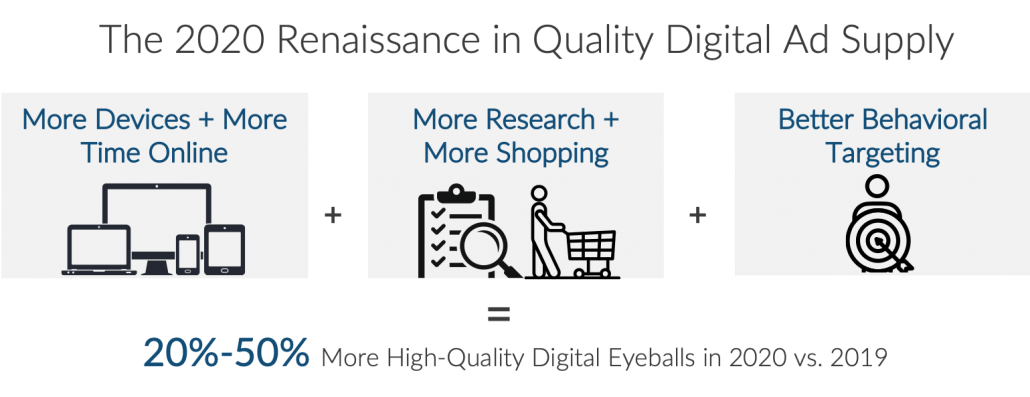Digital Advertising 2020: A Lot More Quality Digital Eyeballs
Of all of the emergent phenomena that have occurred over the past nine months, one that hasn’t gotten much press is the dramatic increase in the supply of quality digital impressions.
There isn’t a published source measuring this very real metric—it has to be triangulated between total impressions, e-commerce sales, click-through rates, and prices—but marketers across many categories know that digital marketing is killing it right now. A lot of ink has been spilled on LinkedIn touting how the pandemic has forced companies to “digitally transform”; but perhaps more importantly, consumers have been forced into a digital transformation of their own.
As people have changed their lifestyles across the world, three things have happened simultaneously:
- More Devices and More Device Time: Consumers are spending more time on more devices, for work or personal reasons
- More Research and More Shopping: People were forced to e-commerce early for necessities, but quickly started using online shopping as a way to forget about the pandemic
- Better Behavioral Targeting: Advertisers have gotten much better at finding consumers when and where they are ready to buy
Let’s break these three trends down.
1. More Devices and More Device Time
As hundreds of millions of consumers across the globe were forced to isolate in early March, device usage has surged across two primary use cases:
- At-Home Work / School: White-collar workers are at home on their devices, with less compartmentalization between work and home digital life—leading to a lot more web browsing. Students are at home on their devices all day, oftentimes with one screen for virtual school and the phone close at hand for social media.
- In-Person Socialization Replaced with Digital: As in-person friendships have been cut off, more people have connected online—which has led to more active digital social networks, and in many cases, the resurrection of old friendships.
The pressure to do more online—whether work or school—has led to an explosion in laptop purchases and usage. For months, laptop sales reached levels not seen in years. In the second quarter of 2020, 64.8M PCs were shopped, compared to 63.0M in the same quarter in 2019—after years of stagnant or declining growth. This growth continued into the third quarter, with 71.4M units shipped, compared to 68.9M in Q3-19. Laptop growth was particularly strong, up 28% in Q3. All of these PCs and laptops are additional sources of quality eyeballs. Several clients have noted that display ads and searches have shifted significantly back towards laptops, after a decade of inexorable movement towards small screens. This is good news for marketers for two reasons.
First, 99% of searches and impressions on laptops occur through the browser (vs. through apps on smartphones.) In-browser ad targeting is much less restricted than in-app targeting, which is hindered by devices restricting data transfer (such as identity) between apps.
Second, e-commerce is more seamless and effective on a laptop than on a small screen. The ability to enter the payment card information, research caveats, and contracts, and see more things on a big screen reduces buyers’ remorse and leads to better conversions.
At the same time, PC use has dramatically increased due to online school and work, and mobile device usage has extended its pre-pandemic winning trend. Twitter, Instagram, and TikTok usage have continued its inexorable rise as a “break” for the daily reality of the pandemic, and as a substitute for physical meetups with friends. Twitter’s monetizable daily active usage (mDAU) grew 34% and 29% year-over-year in Q2 and Q3-2020 respectively, enjoying a clear spike in usage during the pandemic as people searched for solace—or “doom scrolled” putting it more bluntly.
The pandemic has also pushed users who had been falling away from legacy networks like Facebook back into the fold. The monopoly these platforms built up over the years as single-source “friend address books” is a utility with a lot more value during a pandemic, even as the documentary “The Social Dilemma” drove negative PR for social networks’ engagement-focused engineering practices. Facebook’s monthly active user count jumped for the first two quarters of 2020, from 2.498B to 2.701B, an increase of 8.1%, compared to an anemic 4.0% growth in the first two quarters of 2019.
And that’s just reach; time-on-device is also increasing. Daily time spent on social networking (in minutes) had been climbing at around 5% per year since 2014. While I couldn’t find data yet for 2020, I’d bet a lot that this number is way up for 2020.
Combining these data points together, let’s estimate that we’re conservatively at something like 15% more usage in aggregate—across all media platforms—this year vs. last year online.
2. More Research and More Shopping
When the initial surge of Covid-19 drove consumers indoors in March, the focus was on essential items. Toilet paper, flour, yeast, and Clorox wipes became must-have items. Shoppers who had never used Walmart.com before found that it was a pretty good way to get cheap staples to your house quickly and in meaningful quantities. Grocery delivery services were booked a week out, and Uber and Lyft drivers shifted from driving people to delivering meals.
However, this initial period also rapidly expanded to “splurge” items. Everything from alcohol to home improvement items to craft supplies became online searches that more often than not resulted in a purchase. The mindset of “search online first” became cemented in more people, simply because a trip to a store or a mall for inspiration wasn’t an option. For years, marketers and go-to-market consultants have talked about the pre-shopping learning process for complex, considered purchases. 2020 was the year that this ritual became universal.
The data bear this out. U.S. eCommerce revenue grew only 14.1% year-over-year in Q1-2020, but jumped to 30.1% for the first half of the year, as consumers shifted their purchases online. This accounted for a massive 3.7 percentage-point shift in online’s share of total U.S. retail sales in the first half of 2020 alone.
This shift in behavior has been a bonanza for brands and stores that can capitalize. More research means that organic search optimization and paid search are, even more than before, critical for businesses. Demand capture at the point of search is simply critical. Brands that have been able to anticipate consumer needs, and be there on the first page, above-the-fold results, have seen leads and sales increase during a massive recession. This cuts across categories.
At the same time, all of this shopping behavior has been critical “data fuel” for ad networks and modelers. We simply know a lot more about consumer needs and real-time intent than we did nine months ago, which leads us to the final ingredient in the 2020 digital ad supply renaissance: better data-based, behavioral targeting.
3. Better Behavioral Targeting
More people online, more time spent online, better devices, and more shopping online means more data—and when that data is combined with better ad tech and ever-improving AI, we get to better targeting. Put simply, the ability of marketers to place the right message in front of the right buyer at the right time is also better than ever.
Two years ago, there was a lot of chatter about whether peoples’ phones were listening to them and then serving them ads. This theory was debunked; data sources and machine learning had simply gotten uncannily good at finding consumers when they are ready to buy. Gradually, consumers have come to accept that the ads they receive on Instagram, for example, will just be uncannily spot-on.
The brands that have emerged during the pandemic as digital advertising darlings have a few things in common.
- First, they are clearly positioned as scratching an itch that is pandemic-related. Solo Stove came out of nowhere to become a buzz-worthy brand due to a confluence of Covid-19 necessity (how will we gather outside during a pandemic?)
- Second, they have distribution figured out. As I’ve discussed in the previous article in this series, stores like Home Depot and Dominoes that made Spring 2020 investments in safe pickup are doing very well, as are micro-brands that offer free, quick shipping.
- But third, and perhaps most importantly, successful brands have gone back to marketing basics by focusing on segmentation, targeting, and positioning—and then using identity resolution, big data, and great creativity to drive conversions. In other words, a lot of the quality eyeballs equation is being driven by better one-to-one content delivery.
This has been further strengthened by the omnichannel delivery of consistent messages. The ability of marketers to retarget—and retarget across tight social networks—has improved dramatically even in the past year. Consistent, relevant impressions delivered across multiple platforms to tight groups of friends and family is the state-of-the-art for digital acquisition in 2020. It’s no longer creepy—it’s expected.
Conclusion: Go All-In on Digital
Initially, many advertisers seemed reluctant to take advantage of all of these new eyeballs, fearful that consumers wouldn’t spend. This was a serious mistake in retrospect. Prescient brands saw the pandemic as an opportunity, “staying in” in a high-supply, low-cost environment—gaining precious time in building their brands, honing their messages, and perfecting their targeting. These brands seem to be winning as we head into the fourth quarter of 2020. Given that the pandemic is very much still with us, there is no reason to think that this trend will change. The era of the “quality digital eyeball” is with us.
Of course, this is becoming clearer to marketers by the day, pulling advertisers back into the market, and driving prices-per-impression back up. However, even in a higher-cost environment, marketers can still win in this digital advertising-dominated world, by sticking to basics:
- Only buy high-quality impressions, and be wary of too-good-to-be-true CPMs
- Stick with good old-fashioned segmentation and targeting (who wants your product, specifically) and positioning (how will this product scratch an itch—and build creative to get that done in ten seconds or less)
- Reach and frequency: double-down on identity matching and AI to deliver a lot of impressions to likely buyers and their close contact and families
- Invest in multi-touch attribution to better understand which channels are working and which aren’t
- Avoid buyer’s remorse by assuaging all buyer concerns upfront—particularly around payment, commitment, and safety (particularly vis-à-vis Covid-19)






